What cannot be denied, must be justified. This has been the bread and butter for our “renowned historians” when they sit and write, rather fabricate, the history of our country in order to pursue a narrative. The “secular” approach towards history has tried to whitewash a lot of wrongdoings and this line sums it up very neatly. Fabricating reality, falsifying information and hiding the facts is something which is not alien to us, especially in present times and a major victim of this “narrative building” has been the people of this country who have been subjected to this justification. The idea of the freedom struggle has been peddled to us as majorly a “non-violent” movement which was carried out on the shoulders of “ahimsa”. But, the movement has been a non-violent representation of a rather violent struggle that had been going on parallelly. We all know about the Jallianwala Bagh massacre of Indian people by the hands of the Indians on orders of the British but little do we know about another brutal and bloody genocide of the Hindu population in the Malabar region which occurred just two years after the Jallianwala Bagh incident by the hands of fanatic Moplah crowd, which-not surprising at all-has been fed to us, or rather justified to us, as a peasant rebellion against the British and Hindu oppressive landlords.
Over the years historians have tried to dig out the reasons for the happenings in Malabar in the 1920s. Still, after meticulous research and reading a number of deep factual analyses, the reason behind the “uprising” finds its roots not in the political diaspora of that time, but in the mindset of the people involved and the very “peaceful” and “patriotic” Khilafat movement.
The history of Kerala and the meaning of Moplah:
Lord Parshuram took Brahmins from the North and settled them around 64 villages along the coast and the region was named Kerala. These brahmins were called the Nambudiris who for a long period of time carried on the administration of the place by a council of 4 members who were elected by these villages. But eventually, the administration of the place started getting difficult so they brought in military governors from the adjoining countries known as Permuals. They used to govern for a period of 12 years but as the last consecutive Perumals resigned for various reasons, Cherman Perumal the last of the Governors ruled for a period of 36 years.
Around this period (8th and 9th century), the coastal regions of Kerala had a thriving trade relationship with the Arabs. Travel was very common and eventually, some of the Arab merchants and traders started settling down in Malabar. Interactions led to proselytism which also persuaded Chermana to convert to the Muslim faith and somewhere around 825 A.D. (according to the Malabar Manual by William Logan) he travelled to Mecca after dividing the region amongst his subordinates and he asked the local Arabs to travel to Malabar to propagate the Muslim faith. The Arabs, 15 in number led by Malik-ibn-dinar came to Malabar and with the permission of the then rulers built 10 mosques in Malabar and South Canara and started the process of proselytism. The Arabs married the local population and hence were called sons-in-law (‘mapillai’) of the Malabar. As time passed, Arabs lost their hold on the trade monopoly as the Portuguese took over. Soon the previously settled Arabs in Kerala started looking for other means of livelihood. Many of them became mercenaries for hire and some of them went out for manual labor.
In 1789, a Mysorean force under the leadership of Tipu Sultan invaded Kerala which started the era of forcible conversion and killings of the Hindus.
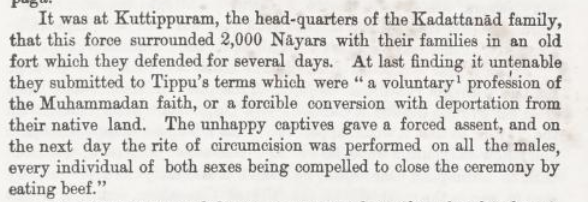
Tipu was hell-bent on converting the Hindu population to his faith. However the treaty between Tipu and the East India Company on 18th March 1792 where he was forced to yield Malabar to the British. The British allied with the Hindu Kings to throw Tipu out of power which was not taken lightly by the local Muslim population. Their defiance of the British was a no-brainer as they were looked at as the perpetrators who overthrew the rule of Tipu Sultan under whom the Ernad Muslims enjoyed great power at the cost of the high-class Jenmis or the Hindu population at that time. The earliest accounts of the British Joint Commissions on Bengal and Bombay in 1792-93 clearly state that the persecution of the high-class Jenmis who were largely of the Hindu population was so much that they had to migrate to Travancore that a Hindu ruler promised for their safety. After returning from Travancore, troubles arose as the Muslims for one reason, or another started the process of Hal Ilakam (religious frenzy) where they started forcibly converting the Hindus and those who refused were brutally murdered. These events carried on for a while after some of them were gunned down by the British.
When the British came to power in 1792, it was habitual for the Jenmis and Nayars to reclaim their ancestral land and the British were also committed to restoring the lost structure of the system.
The British knew that this transfer might not only cause dissatisfaction but there might be chances of some open rebellion by the “Mapilla Kanumkars” who during the exile and persecution of the Jenmis by Tipu had gained significant power and position. The British thought that the Jenmi-Kanamdar dispute could be resolved by re-installing the Jenmis or the Hindus in their prior positions as the Landlords but this did not come out as expected. There were frequent skirmishes between the Moplahs and the Hindu “Rajas” during the 1790s. There was open defiance towards British rule in the early 1800s with an ambush of George Waddell, the Southern Superintendent of Malabar and the destruction of the cantonment and cutcherry at Urugrm. The Moplahs were of the mindset that they were in defiance of a power that was allegedly favourable to the High-class Hindus.
Several outrages started happening in different regions of Malabar and to inquire into this the British appointed Mr. T.L. Strange as the special commissioner in Malabar and his report published in 1852 gives a very clear picture. Historians have tried hard to whitewash these outrages as a rebellion against the atrocities committed by the High-class Hindus on the poor peasants who were just responding to their oppression at the hands of the landlords. But the evidence speaks volumes that this was not the case. Strange in his findings was very clear that the reasons for these outbreaks were religious fanaticism and not agrarian discontent. He further added that the teachings of the Muslim clergy added to the discontent of the Moplahs, and they were directed towards the killings and conversions.
It is apparent thus that in no instance can any outbreak or threat of outbreak that has arisen be attributed to the oppression of tenants by landlords. A great clamour is now raised on this regard prominently in the southern taluks visited by me, the Mappilla population seeking to throw the blame of these outbreaks upon the landlords by thus charging them with being the cause thereof. I have given the subject every attention and am convinced that though instances may and do arise of individual hardship to a tenant, the general character of the dealings of the Hindu landlords towards their tenantry, whether Mappilla or Hindu, is mild, equitable and forbearing. I am further convinced that where stringent proceedings are taken, the conduct of the tenants is, in the vast majority of cases, the cause thereof, and that the Mappilla tenantry, especially of the taluks in South Malabar, where the outbreaks have been so common, are very prone to evade their obligations and to resort to false and litigious pleas.
T. L. Strange in his report of 1852
Period of unrest (1836-1919):
This was a timespan where frequent Moplah outbreaks were seen in Malabar. Conrad Wood in his meticulous account of the genesis of the problem gives a detailed analysis of the killing that took place during this time, how many people died and what preparations were made prior to the event. In total, 29 outbreaks were recorded between 1836 to 1919 in which all the people who died were Hindus except for 2 collectors of Malabar, H.V. Conolly who was killed in 1855 and C.A. Innes who barely escaped the same fate as his counterpart in 1915. Here is a detailed account of the 29 outbreaks:
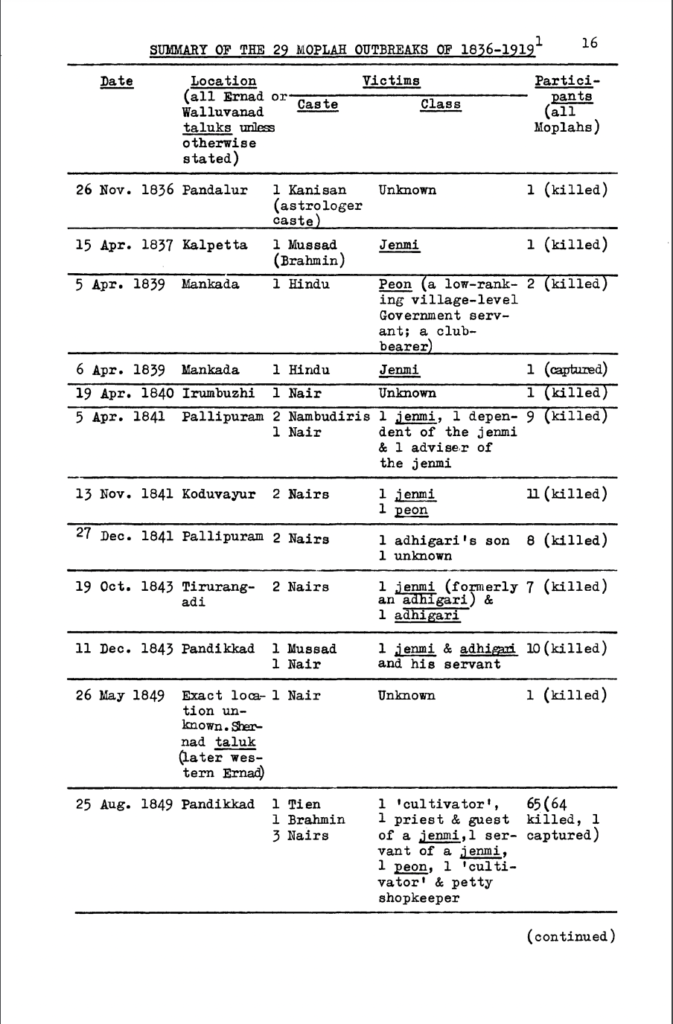
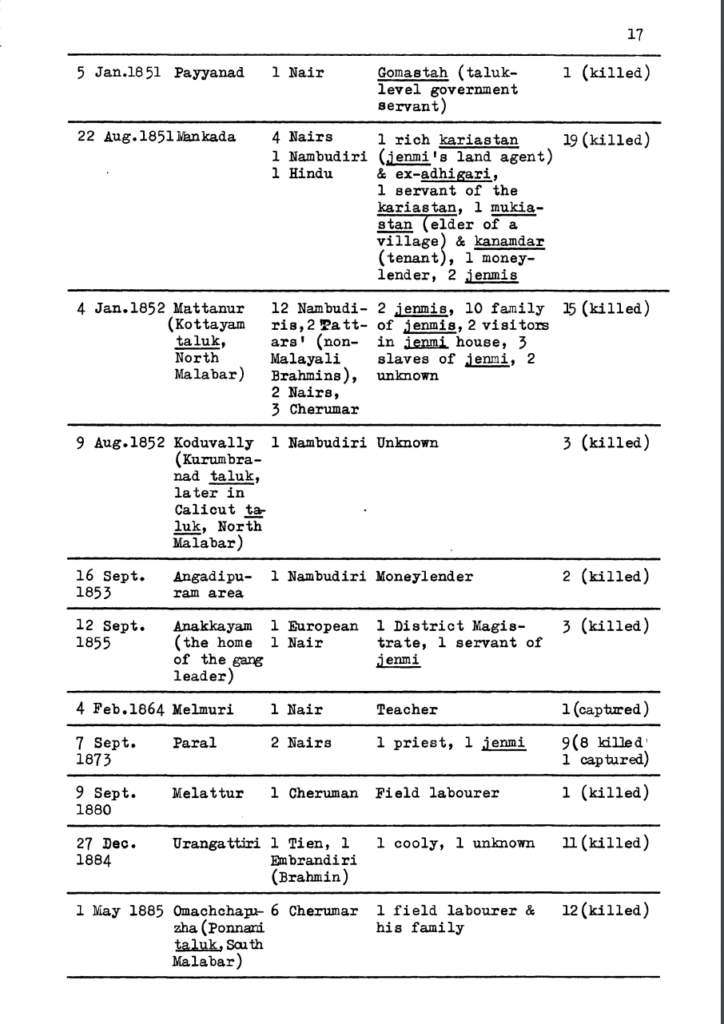
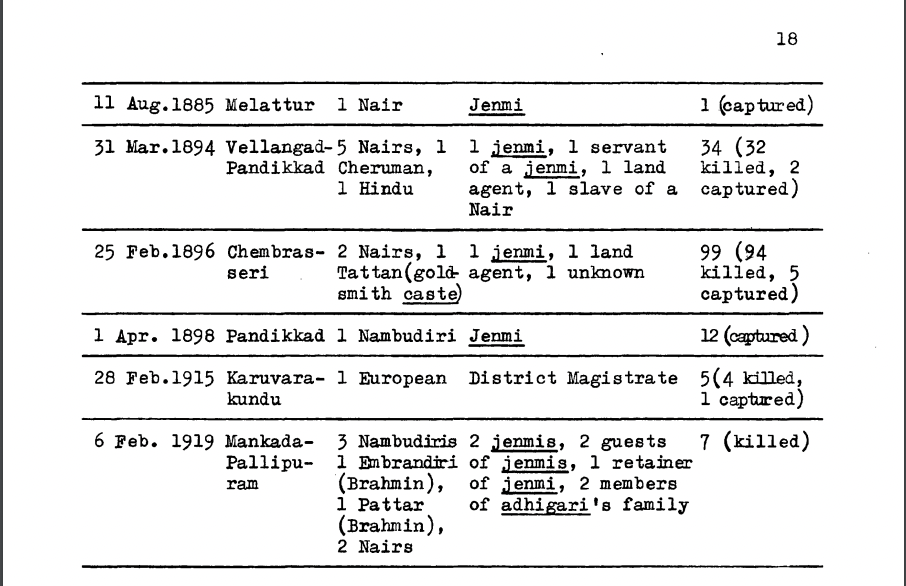
Of all the 29 outbreaks the number of Moplahs involved was somewhere between 1 to 19 which depended upon how quickly the government forces were able to curb the outbreak. In one of the incidents in 1896 which prolonged for several days, the number increased to 99 and others came on to join. Some important features of these outbreaks were that the people involved in the outbreaks were of the working class who barely had enough to make ends meet. They were daily wage workers, tenants, field labourers, porters, medicants etc. In fact, one of the reports reflects on the collecting wealth of a dozen Moplahs who were caught in 1896 and the total amount was a mere 205 Rupees. All these men were brainwashed by the Tangals (Sayyids or descendants of the Prophet as called in Malabar), and they had to seek their blessings every time they went out.
The preparations before the outbreaks included dressing in white, divorcing their wives, and seeking blessings of the Tangals but the most important aspect of these preparations was the fact that none of the people involved had the intention of coming back. In other words, they were there to become martyrs and to support this fact, after carrying out the said objective of killing the Hindus, ravaging and burning down their houses and temples, the Moplahs would sit and wait around for the forces to arrive. After their arrival, they would choose a place of shelter, preferably a house of their victim, a temple or a mosque and the objective was to not be captured alive. They would shout war cries and prayers and the climax included coming out of the place of hiding in huge numbers and engaging with the forces in hand-to-hand combat, laying their lives eventually.
The main objective of becoming a “martyr” in this endeavour was the belief that they were doing a deed in the name of Allah and that the martyrs would be rewarded accordingly in their afterlife. One can easily draw parallels with contemporary situations as well where men from lower strata of society are brainwashed in the name of some reward in the afterlife. They had no intention of running away at the hands of justice, but they were totally in for a suicidal charge against the forces and had no intention of coming back. In the words of one of the Moplahs who was caught alive, “We came to the temple intending to fight with the troops and die. That is what we meant to do when we started.”
Let’s not set aside a very important aspect of all this, the agrarian issue. The Jenmis or the High-class Hindus were the landlords, and the Muslims (Kanamdars) were the tenants who worked in those fields. The new tenancy laws were introduced by the British which enabled the Jenmis the right of overleases which means the Jenmis were able to sell or literally auction to third parties the right to remove any one tenant. This was no doubt a cause of grievances in the working class Moplahs but there is no denying the fact that they were more outraged by the fact that the people in the places of authority or power over them were “mostly Hindus”. This can be understood as to why the Hindus killed in the outrages were not only High-class Jenmis but also some who were not landlords and were amongst the slave class and were equally vulnerable to the oppression of the ruling class Hindus.
The British government needed to find a solution to stop these outbreaks and killings. As the situation escalated, the government started acting. Measures were being formulated which eventually led to the appointment of special commissioner Mr. T.L. Strange in 1852 who was appointed to assess the reasons for the outbreaks. The officials acted on his orders and were able to persuade Syed Fazl, a Mambram Tangal of Ernad who was responsible for planning many of these outbreaks. However, the most repressive step was the formulation of the Moplah Act of 1854. The act banned the use of the Moplah war Knife, the deportation without trial of anyone was even suspected to have been associated with any kind of outbreak or skirmishes, the confiscation of property of the people involved and levying fines on the inhabitants of the localities of the participants involved. This act did prove to be working as the outbreaks started decreasing but that did not mean that everything was fine. This act further fueled the fire in the Moplahs.
H.V. Conolly the governor was murdered in 1855 for he took the responsibility of the hounding of Mambram Tabgal Syed Fazl. According to Pathooma, a Moplah Muslim woman, when asked about their pursuit of Conolly, they responded, “Is it not the case … that our Pookoyah (Syed Fazl) is not to be seen in the country?” C.A. Innes was also attacked in 1915 because he tried to return a young Tien ‘convert’ to his previous relations. The preparations of Killing Innes were going on for a long time and his travel routes were being cautiously regulated by at least a thousand Moplahs.
The fall of the Turkish Caliphate and the Khilafat movement:
In order to understand the real motive behind the massacre of Hindus in Malabar, one needs to examine the aspect of the Khilafat movement minutely and connect the dots to finally see the picture behind it. Turkey had stepped into the First World War in support of Germany against the allied powers which brought it to loggerheads with the British. It sought this as an opportunity to gain back the territory that it had lost in the preceding Balkan War. Stepping in of Turkey in support of Germany forced the Indian Muslims into a fix as they did not know what to do, whether to support Turkey or preserve their interest and loyalty to the British in India. This caused a lot of panic among the Indian Muslims as they saw Turkey as security amidst the Hindu Majority in India. Turkey at that time was home to the Ottoman Empire and was the seat of the Muslim “Khalifa” or the Caliphate. The Khalifa or the Caliph was considered the leader of the Muslim Ummah or the universal Muslim brotherhood which transcends national, racial and class divisions to unite Muslims all over the world. It was the only surviving Muslim Empire ruling a large number of Christian population and was also capable of resisting Europe which was a matter of pride for the Muslims of foreign domination. So the Caliph was not only seen as a political leader but also a religious leader for Islam and Muslims all over the world. An aspect that is vehemently discouraged is why the Ottoman Caliphate had so much significance to the Indian Muslims? The answer to this question is a bitter pill that needs to be digested. The answer to this question lies in the very concept that led us to give away 1/3 of our land but the entire truth regarding the very concept is still alien to us, the two-nation theory and the duality of nationalism. We will cover this in our coming blog.
The British were able to convince the Muslim leadership of those times that they were the actual rulers of the land called Bharat as they had “conquered” this land and in order to save them from the “barbaric” Hindus, they needed to ally with the British. However, the fall of Turkey in November 1918 plunged the Muslim world into grief. It turned the Indian Muslims hostile towards the British as they were held responsible for the misfortune of Turkey.
The Armistice of Mudros signed between Turkey and the allied powers on October 30, 1918, led to its unconditional surrender. The European war finally came to an end with the capitulation of Germany on November 11. There was a belief amongst the Indian Muslims that as a reward for their loyalty, the British would treat Turkey with generosity, safeguarding their interest. On the contrary, several treaties signed between different nations stripped Turkey of not only its entire European possessions including the capital Constantinople (now Istanbul) but it also lost Mesopotamia, Syria, Arabia and Palestine. In short, Turkey was left with nothing, not even easy access to the sea routes. The harsher treatment of Turkey was a reason for resentment amongst the Indian Muslims toward the British. The war-time promises made to them were shattered and they were also worried that after the fall of Turkey, their status would also be reduced to the status of Jews- a religious sect with no Kingdom. To add to their displeasure the Government of India nominated Lord Sinha of Raipur, a Hindu to represent the Muslims in the Peace Conference. The Muslims thought that however righteous, a Hindu would not be able to best serve the Muslim interest and to convey their needs to the government in the way they want it to be conveyed.
Certain major and minor incidents started giving rise to newer faces in the political diaspora of the country. In 1916, a Mosque was demolished in Kanpur on the orders of the local collector and the Temple was saved because of the Congress’s allegiance with the British. This was the incident when the Ali brothers (Mohammad Ali Jauhar and Shaukat Ali Jauhar) stepped into the picture. They realised that the Muslim league was dominated by the people who were loyal to the British so they set out to start a movement that would preserve the Muslim interest both inside and outside the country.
The session of the All India Muslim League in Delhi gave an excellent opportunity for them to showcase their discontent publicly. Special invitation was given to many prominent Muslims and Hindus to attend the conference on December 30 and 31, 1918. The sole demand of the Muslims was to remove all non-Muslim control from the Jazirat-ul-Arab (Arabia, Palestine and Mesopotamia) and the territories be restored to Sultan Caliph Vahid-ed-Din Mohammed VI. The conference served the rightful purpose of showing the on-mass protest against the Government of India. This was also the first Muslim league session that closed without the usual cheers to the King Emperor. These demands were also proposed to the British in London when Mohammad Ali Jauhar led a delegation. The British threw his proposals out of the window. They could not digest the fact that how could they treat Turkey differently when it had participated equally in the war along with Germany.
All this led to the formation of the Khilafat committee. A committee solely of the motive to revive and restore the “glory of Islam” and the Turkish Caliphate. Several processions were taken out and people were being recruited to support them. They set out on a nationwide tour to enlist people for support of the cause but they met with very little success. In spite of great efforts, they were not able to make it a mass movement. Suddenly, they started getting support from unexpected quarters. The Khilafat committee was now getting into the play and the committee suddenly became a movement that had people coming in from all quarters. The name of this support was Mohandas Karamchand Gandhi. He came in as a blessing for the Khilafatists as his stepping into the picture brought in the Hindus of the country to support the movement. Knowing perfectly well that the Khilafat movement had nothing to do with the freedom struggle of the country, the support of Gandhi was just a bargaining chip as he asked Abdul Bari (one of the prominent leaders of the Khilafat movement) for his support to the Satyagraha or passive resistance against the problematic Rowlett Act. At first, Abdul was sceptical of this as he thought that the support of Hindus would be harmful to Muslims, but seeing the possibility of making this a mass movement, Abdul Bari grabbed this opportunity with both hands. Both Gandhi and Bari were utilising each other for their personal advantage. Gandhi sought Muslim support for the Satyagraha and Bari sought Hindus for making it a mass movement. Utmost devotion to the Muslim agenda was demanded by the Hindus.
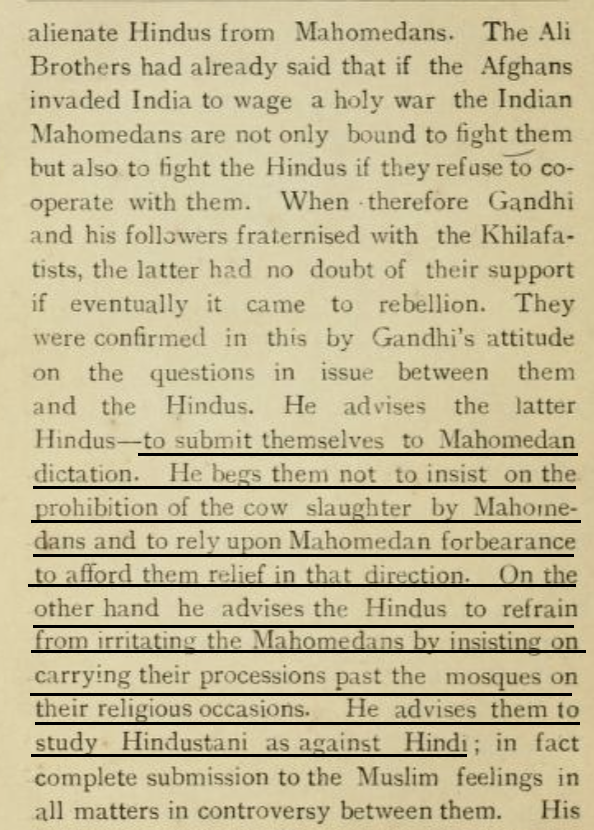
Ali Brothers in late April 1919 wrote a letter to the viceroy of Chhindwara where they again proposed the demand of giving back the lost territory to the Turks and restoring the glory of the Caliph. Seeing no heed being paid to their demands, they threatened the British saying if their immediate demands were not being taken into account in a given time frame the Muslims would perform Jihad (religious war) or Hijrat, which meant migrating from Dar al-Harb to a dar al-Islam. The concept of Hijrat states that it is not fit for a Muslim to live in a place that is not governed under Islam so he/she should migrate to a land of Islam (Afghanistan in this case) and come back again in the hopes of conquering the land again.
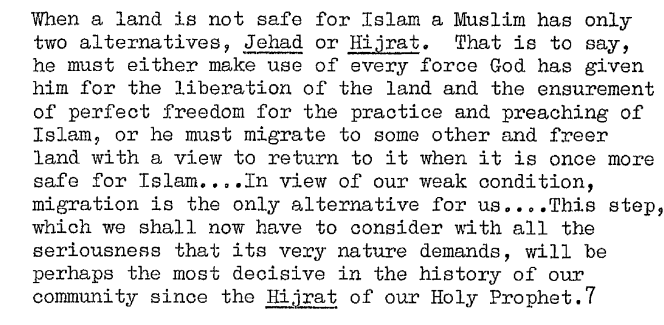
This partnership of Gandhi and Ali brothers led to a supposedly Hindu-Muslim unity throughout the country and is justified to the extent that this Khilafat-Non-Cooperation movement was done to stand against the British Empire but the evidence clearly states that the motive behind this merger was entirely different. Such was the unity that in 1920 in the town of Malegaon in Maharashtra, a Muslim mob attacked a police station, assaulted a number of police officers, burnt down a Temple, threw the body of the inspector into that fire and burnt and looted houses of all the Hindus who opposed the Khilafat movement. A number of such riots took place around several regions in India. The objective was simple, either you are with us or against us. A similar incident took place in Barabanki near Lucknow, Uttar Pradesh. An entire Hindu community was barbarically targeted for not showing support for the Khilafat, men and children were killed, houses were looted and burnt, and women were raped. To quote Mohammad Ali, “If the Afghans invaded India to wage the holy war, the Indian Mohammedans are not only bound to fight with them but also fight the Hindus if they refuse to cooperate with them”. Clearly, Gandhi’s idea of non-cooperation was accepted but the Gandhian approach of non-violence was not.
Shaukat Ali when he came to Srirangapatna in Karnataka, also visited the Dargah of Tipu Sultan after which he made a public appearance calling his visit a pious one where he called Tipu Sultan a National hero. How much of a hero he was is not unknown to us. A man who slaughtered Hindus and was bound on his mission of religious conversion forcefully is indeed a “hero” and should be celebrated. Apparently, there was a T.V. show based on his life which was called “The Sword of Tipu Sultan”, which shows his “valour and devotion for his country”.
The Khilafat movement soon turned worthless after certain incidents took place in Turkey. When Mustafa Kemal Ataturk came to power in Turkey and made some changes in the political standings. He won back some of Turkey’s lost territories but also thought that the presence of the Caliphate was single-handedly responsible for them being at constant loggerheads with the Western world because they believed this Caliphate would be the reason for the revivalism of Islam. He decided to take away the idea of a Caliphate and turned the Parliament of Turkey into a Caliphate itself, meaning, the Caliph or the Khalif was now not an Individual but an entity. This had never happened in the history of the Islamic tradition but Kemal went a step further and demolished the title of a Caliphate altogether. This was a major setback to the Khilafat movement because the agenda on which the foundation of Khilafat was built was shaken brutally. Every promise made by the Muslim side now stood null and void and then started a series of bloody riots all around the country. Some of these riots in places like Bihar and other places led to greater concessions given to the Muslim league because the Hindu side responded to these attacks. So now self-defence was also seen as an attack.
The Moplah Genocide of Hindus: August 1921:
The whole premise of Gandhi’s approach towards the freedom movement was based on non-violence. Historians have carved our history in such a way that for years we have believed this to be a gospel truth. But as said earlier, it was a non-violent representation of a violent struggle. Enough whitewashing has been done and the suffering has been caused by the Hindu people. The Islamic approach of either converting or killing the ones who do not agree with them has been the problem all along. The genocide of Hindus by the fanatic and barbaric Moplah crowd is one of many such massacres but definitely one of the most brutal of them all.
As said before several meetings used to take place in different regions of the country for recruiting people and collecting funds for the Khilifat movement. Gandhi and Ali brothers were at the forefront of these meetings and they travelled together all around the place influencing and requesting people to join hands while the Muslim crowd kept on killing and plundering Hindus who did not agree with them. Gandhi, supposedly “unaware” of this “ahimsic” approach kept on going relentlessly in support of the Ali Brothers in order to achieve some “Hindi-Muslim Unity”.
A Congress session in April 1920 was held in Ernad district of South Malabar which was done to oppose the Montague Chelmsford reforms and also seek recruits for the Khilafat and Non-cooperation movement. The rift between the Extremists and the Moderates was clear in the meetings as well. Anne Besant who also attended the conference opposed the non-cooperation movement. However, due to the heavy Moplah crowd the non-operators who were in opposition to the reforms prevailed and also the resolution for the Khilafat movement was also proposed and approved. This led to local Khilafat committees being formed in districts like Ernad. People were appointed to collect funds and several small and medium committees and groups were formed every day to have discussions. One of these collectors was Variankunnath Kunhamad Haji (V.K. Haji) in Ernad. One of the prominent leaders who led the gangs of Moplah in the massacre of Hindus in August 1921, he was later referred to as the “Khilafat King”.
The local Khilafat committee gained further push after the Calicut session attended by the Gandhi and Ali brothers on August 18, 1920. The idea of Non-Cooperation was further moved and Gandhi as usual asked the Hindu population to fully support the Khilafatists in their agenda. The Ernad Talluk which was the epicentre of the outrages of August 1921 was overpowered by the Moplah constituting over 60 percent. Malabar region on a whole had 32 per cent of the Moplah Muslim population.
V.K. Haji invited Maulana Yakub Hassan to address a Khilafat conference in Calicut. The authorities denied giving the permission as they thought that inviting Hassan would instigate the Moplah Muslims not only against the British authorities but also against the Hindus. Even after Gandhi’s appeal to the Malabar Hindus to support the Khilafat cause, they refused to participate in their cause because they were aware of the flaws behind all these agendas. They had centuries worth of experience living with the fanatic Muslims and they did not want to any part of this. The Moplahs on the other hand thought of it as an invitation to war. The denial of permission for Hassan’s conference was ignored by the volunteers and as a result, they were arrested. The Moplahs were furious for this act of the authorities which led to a confrontation between the British authorities and 12,000 Moplahs armed with sticks and the classic Moplah knife. This did not lead to proper violence but the seeds for one of the biggest Hindu genocide was sown. Non-violence was thrown out of the windows. According to C. Gopalan Nair, by June 1921, “every Moplah centre had a Khilafat association, with a Moplah president, a Moplah secretary and a majority of Moplah members. The number of such Khilafat committee is not known, but in Case No. 128 of 1922, on the file of the Special Judge, Calicut, it has been mentioned that there may have been as many as 100 Khilafat committees formed in the two Talluks of Ernad and Ponnani”.
Neither the British authority nor the Hindus had any idea what was going to hit them on August 20, 1921. A large number of Moplah men armed with sticks, knives and other weapons started marching with cries of Allah-hu-Akbar. Killing, loot, rapes and plunders had become the routine of the day. Temples were destroyed, houses burnt down and the authorities and the Hindus had no idea of a plan of action. Between 11:30 am to 02:00 pm on August 20, around 2000 Moplahs armed with knives and Khilafat flags attacked the Moplah regiment and mutilated an officer and a constable. By the evening, railway lines were destroyed to prevent the entry of reinforcements from other regions. By August 22, 1921, Ali Musailer declared himself the “Khilafat King”. On August 26, another round of confrontation took place which led to 400 Moplahs being killed. But the main event was yet to come.
The second phase of the massacre peaked from September to November 1921. For a period of 4 months, the Moplahs massacred Hindus en masse. The troops being unfamiliar with the hilly terrains of the region had no clue as to how to stop the genocide. And still, the Khilafat-Non-Cooperation movement around the country relentlessly continued. Having read multiple eyewitness accounts and several papers written on this, the number of Moplahs involved in the genocide of Hindus during the period of August to December, was close to 48,000. Just for clarity, this was the average size of an army in those times. 48,000 Moplahs slaughtered Hindus brutally for a period of around 6 months. Now we will give some of the details as to the approach of the confrontation. This will not be an easy read.
Note: All these details mentioned below have been verified from multiple accounts and the resources are mentioned at the end of the blog. We sincerely urge the readers to read the material as well, to have a clearer idea of how brutal, savage and inhumane these incidents were.
- Slaughter of Hindu men, women and children.
- Burning and looting down houses in front of the owners.
- Raping and killing Hindu women and girls regardless of age.
- Forcibly converting Hindus en masse and killing those who refused to convert.
- Throwing men and women alive into wells where they had to struggle for hours before they succumbed to their deaths.
- Temples were desecrated, intestines of cows were taken out from their dead bodies and were garlanded around the Murtis of the deity. The heads of the dead cows were hung through the ceilings and roofs of the temples.
- Before killing the Hindu women, the Moplah women (Moplah women and children actively took part in these horrors) would snatch away the clothes and ornaments from them as they were valuable.
- In a unique technique, they would force the Hindu men to dig their own graves and then were killed and buried in them.
An article was written in Times of India by Shankaran Nair titled ‘Diabolical Atrocities’ in which he gives further details. According to the article, “…after forcibly removing the young and fair Nair and other high caste girls from their parents and husbands, the Moplah rebels stripped them of their clothes and made them march in their presence naked, and finally they committed rape upon them. …the Moplahs are alleged to have utilised a single woman for the gratification of the carnal pleasure of a dozen or more men.”
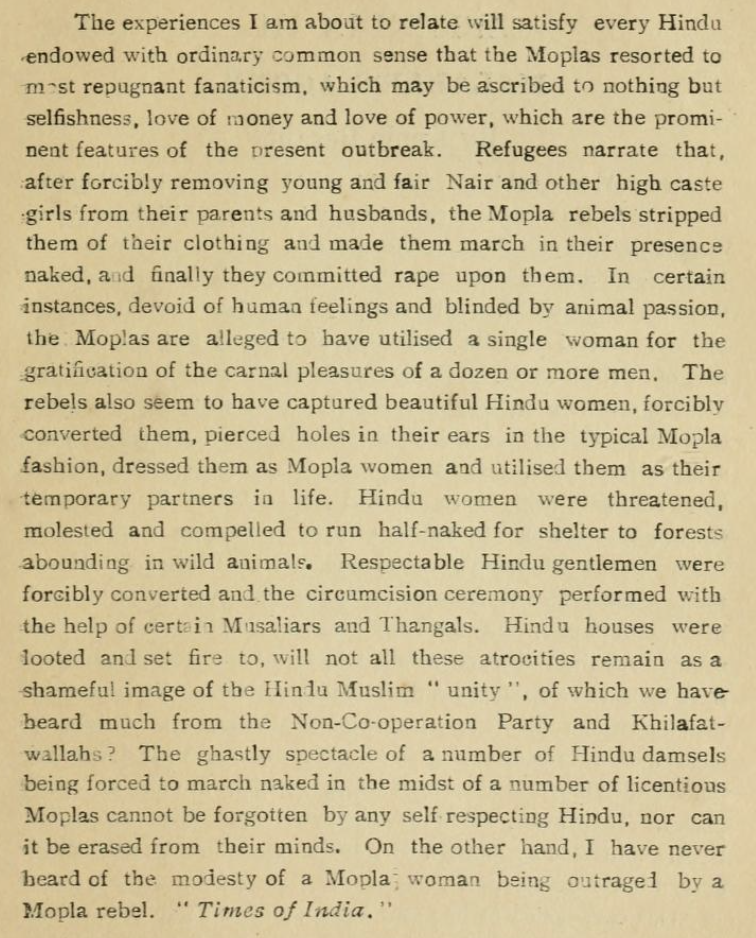
Several other horrifying depictions are written in Multiple eye-witness documents. Annie Besant wrote a stinging open letter to Gandhi criticising him over his response to the happenings in Malabar titled ‘Malabar’s Agony’ in New India dated 29 November 1921. She describes several incidents that took place.
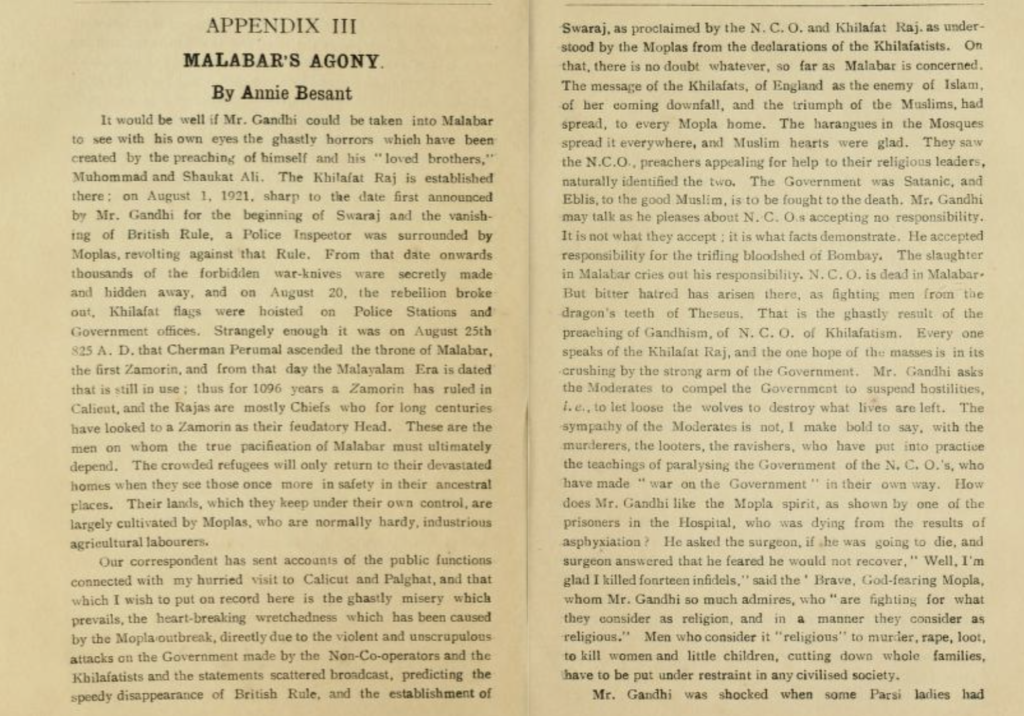
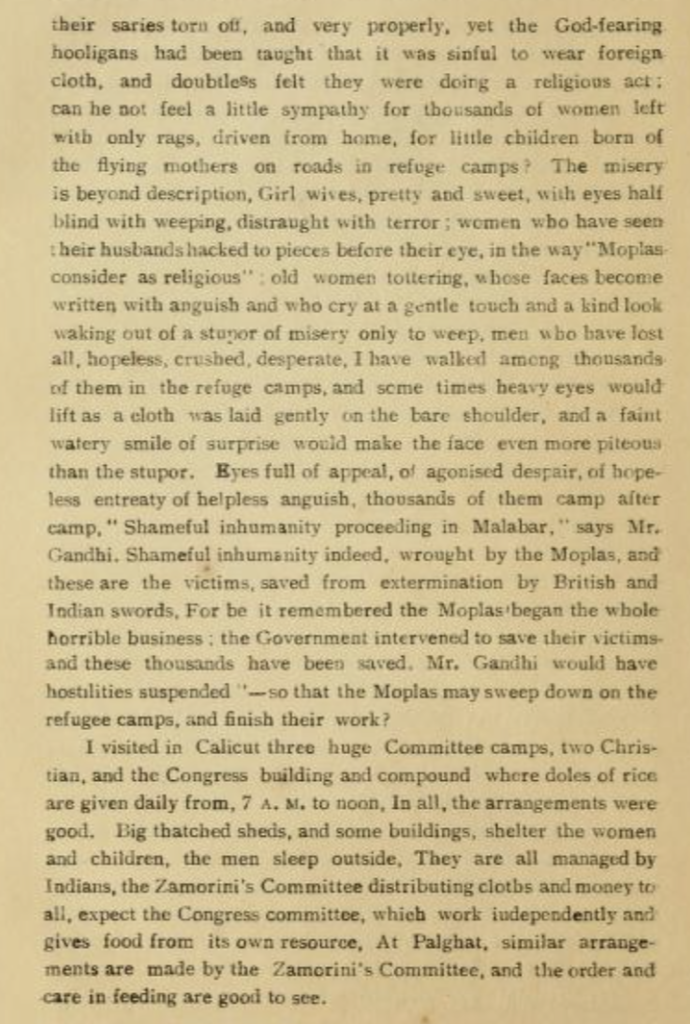
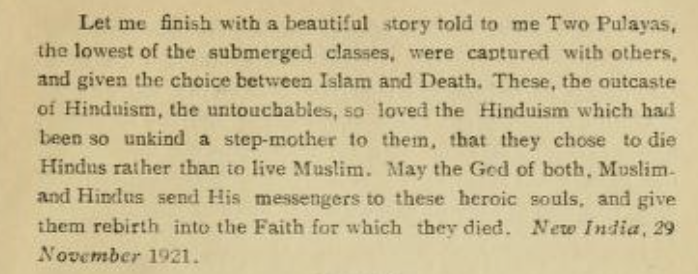
In another piece dated December 6, 1921, she says, “Two days back I had occasion to read a report given by a refugee in Calicut. A pregnant woman carrying 7 months was cut through the abdomen by a rebel and she was lying dead on the way with the dead child projecting out of the womb. How horrible! Another: a baby of six months was snatched away from the breast of his own mother and cut into two pieces”. In another incident, a Nair lady was stripped naked by the rebels in front of her Husband and brothers who were made to stand with their hands tied and she was being raped in front of them. When they tried to shut their eyes they were forced at the point of swords to watch as the Moplah men committed rape on her and eventually killed her.
In broad daylight, 25 men who opposed accepting Islam were killed and put into a well. One of them narrowly escaped and went to the hospital where he described this incident. The Maharani of Nilambur wrote a letter signed by hundreds of Hindu women and was addressed to Lady Reading, the Viceroy Rufus Isaacs (Lord Reading).
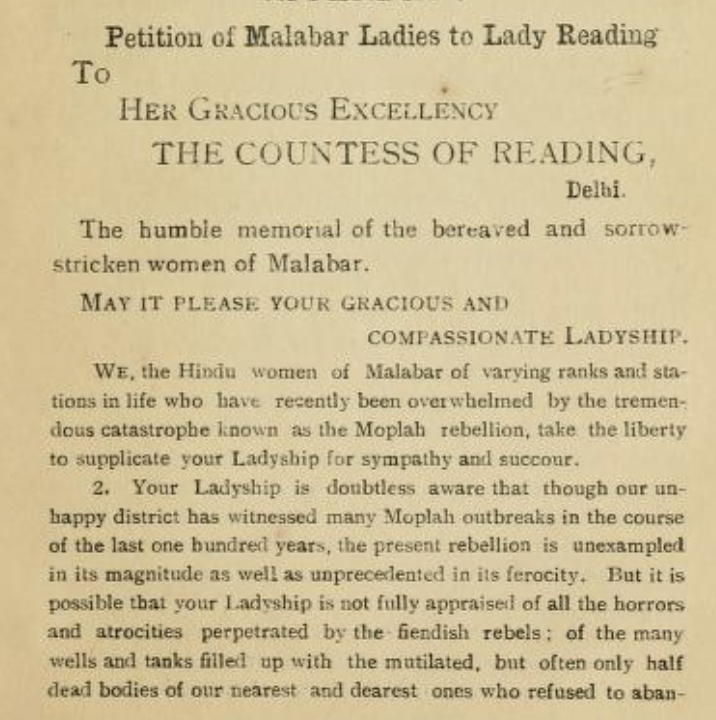

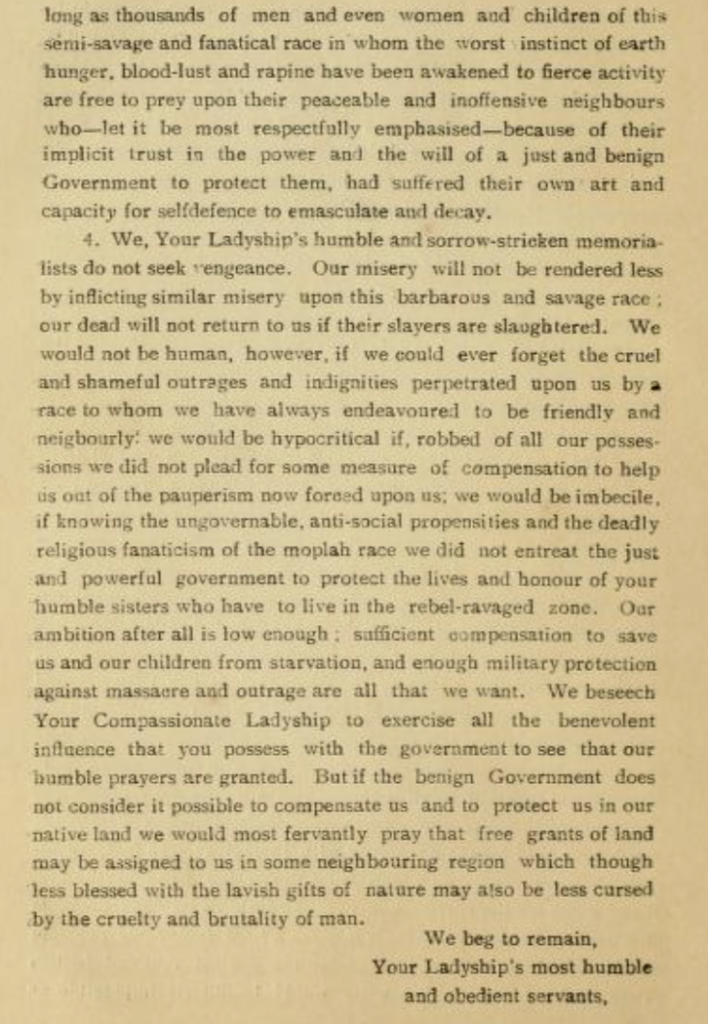
In 1957, E.M.S. Namboodiripad headed the first democratically elected communist party in the country. During his second term in 1967, he created Muslim majority Malappuram district by combining those taluks which were the epicentre of the outrage of 1921. Some critics denounced it by calling it the illegitimate child of the two-nation theory labelling it as Moplastan.
In response to the incidents of Malabar, Gandhi and the Congress passed a resolution in the Ahmedabad session of Congress in December 1921. This resolution was the ultimate act of desecration for the innocent Hindu lives. They said that the “disturbance” in Malabar was not due to the Khilafat movement. It was due to the reasons “wholly unconnected” to the Khilafat movement and it would not have occurred if the message of non-violence was allowed to reach the people. The Congress was of the opinion that these incidents could have been prevented if the authorities of Malabar had accepted the assistance offered by Maulana Yakub Hassan. These statements are captured in the minutes of the Congress proceedings which can be referred to by our readers. Not even a single word of disagreement was uttered against the Ali brothers or the Khilafat volunteers in order to preserve the so-called Hindu-Muslim unity. Hasrat Mohani in his account justified this act by saying that the Moplah committed these acts because they were afraid of the army contingent of the British in that region and they thought that the Hindus had invited the army therefore the “Dara hua Musalman” decided to wake up and massacre Hindu. Apparently, the infamous slogan that we so dearly chant, Inquilab Zindabad was given by the same Maulana Hasrat Mohani. He became so dear to Jawahar Lal Nehru that Nehru framed his photo in the gallery of freedom fighters. As recent as 2014, former Vice-president of India Shir Hamid Ansari released a postage stamp in honour of Hasrat Mohani.
It becomes mighty relevant to quote B.R. Ambedkar in matters of personal propaganda by these politicians, so let us quote him in the matter that matters the most. Ambedkar in his book Pakistan or the Partition of India says,
“It was the result of the agitation carried out by two Muslim organisations, the Khuddam-i-Kaba (Servants of the Mecca Shrine) and the Central Khilafat Committee. Agitators actually preached the doctrine that India under the British Government is Dar-ul-Harab and that the Muslims must fight against it and if they could not, they must carry out the alternative principle of Hijrat”.
B.R. Ambedkar, Pakistan or the Partition of India
Truth is infinitely more of a paramount importance than Hindu-Muslim unity or anything else.
Annie Besant describes a beautiful story amidst all these massacres in his letter on November 29, 1921. Two Pullayas, the lowest of the submerged class of Hindus were captured and were given a choice of death or conversion. These so-called outcastes and untouchables of Hinduism so dearly loved their religion that they chose death over conversion.
Conclusion:
This is the story of the Genocide of Hindus by the barbaric, cruel, fanatic Muslims of Malabar which was justified as a rebellion. Forced symmetry and balance, has been an approach followed when they do not want to state out and accept the facts available. Several different arguments are stated saying there are different narratives available so it is hard to establish the truth. Three different narratives are given, first, it was a peasant rebellion against the socially prominent and powerful Hindu landlords, second, religious fanaticism, and third, the most absurd saying some Moplahs gave shelter to Hindus during the disturbance so one cannot blame the entire community.
But how do you decide whether the nature of the riot was communal or not? It is not done on the basis of the victim and the perpetrator but on the accounts of factual evidence available and the stated agenda and goals of the people involved. Through this blog, we have clearly stated that the reason behind the genesis of the 1921 riots was, one, the downfall of Turkey and the Islamic Caliphate and two, the fanatic message of the Khilafat movement and its leaders.
Promoting unfound symmetry by giving different baseless narratives to satisfy the secular approach and to dilute the factual arguments verified through a number of accounts available. To suggest that Kashmiri Pandits, due to their societal prominence, induced their own exodus or framing the repeated invasions of Somnath as Mahmud of Ghazni’s quest to liberate non-Brahmins from Brahmin control oversimplifies complex motivations. If we are very clear that what happened in Gujarat in 2002 was purely communal, why are we so hell-bent in whitewashing the communal angle of the Malabar Genocide of Hindus?
Emotions and hurt sentiments can kindly take a back seat because now the facts will speak. We have had enough of this secularisation of facts to meet personal goals because somehow in the end the Hindus go through suffering. We encourage readers to delve deeper into this topic to uncover more harrowing tales from that era, as a comprehensive account is beyond the scope of this blog.
Reference/s:
- India Bharat and Pakistan the constitutional journey of a sandwiched Civilisation by Adv. J. Say Deepak.
- The Khilafat Movement in India, 1919-1924 by Muhammad Naeem Qureshi
- Gandhi and Anarchy by C. Shankaran Nair
- The Moplah Rebellion of 1921-22 and its genesis by Conrad Wood
- The Malabar Manual Vol.1 & Vol. 2 by William Logan
- The Moplah Rebellion, 1921 by Diwan Bahadur C. Gopalan Nair
- The Moplah Genocide of Hindus: An Eternal Eternal Reminder by Sandeep Balakrishna
- The Mapilla Rebellion, 1921: Peasant revolt in Malabar by Robert L. Hardgrave, Jr.

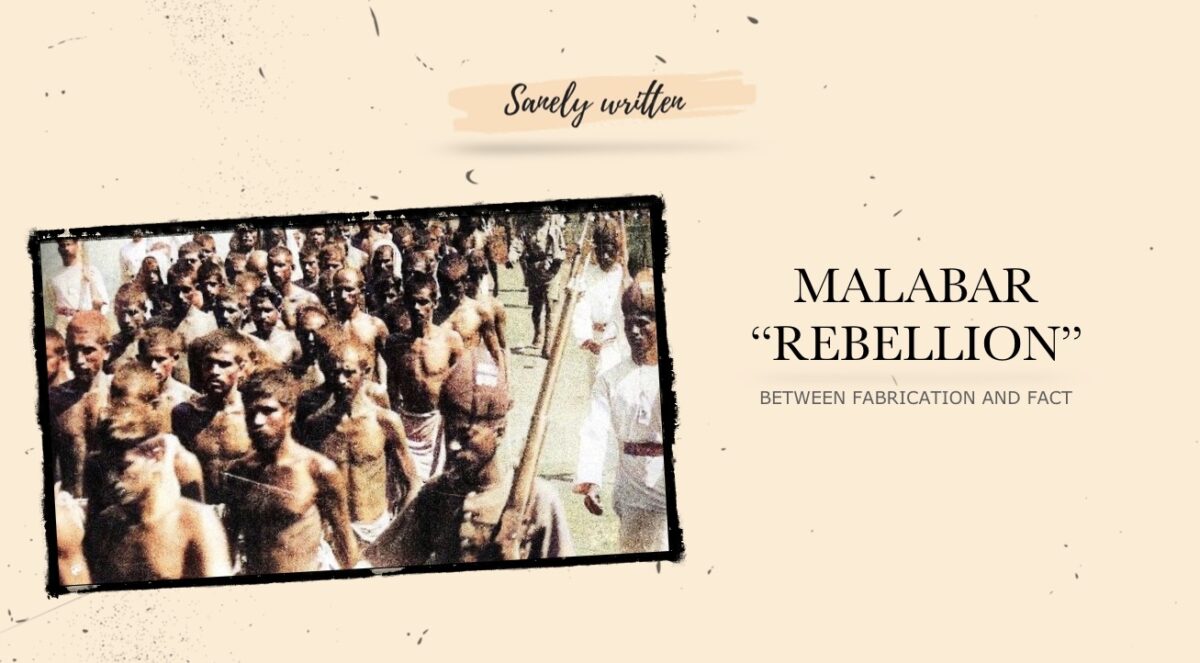


3 replies on “Malabar Rebellion”
Detailed read that immersed me in the profound sorrows and silent cries of the people who suffered this genocide.
Very informative blog.👍👍
Very informative 🙂